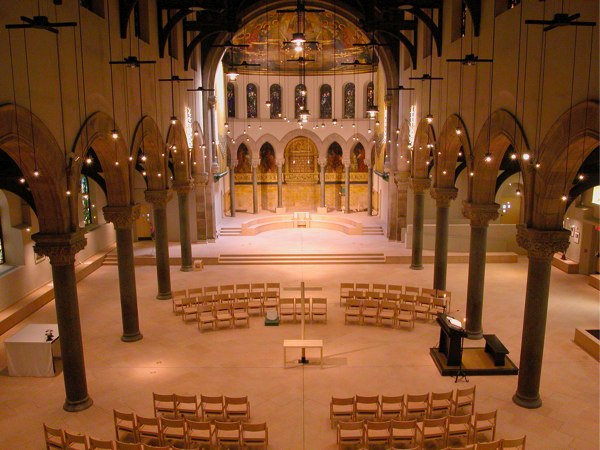Monday, February 21, 2011
Sacred and profaned
One of the many mistakes of the Age of Equality, with its deeply erroneous and misleading assumption that everyone is of equal worth, intelligence, capability, etc. played out in the Catholic Church after the Second Vatican Council of the mid-60's.
Catholic churches prior to that were temples, pure and simple, not "houses for the assembly of the baptized." They were the House of God, with an altar and tabernacle centered sanctuary walled off with the low but clear communion rail. They were full of sacred objects and sacred images and sacred spaces...all of which required a special and unusual set of attitudes and ritual behaviors quite different from the hustle and bustle of life outside the temple. And of course there were sacred persons, priests and nuns.
The volkische populism of the 60's demanded that all this concentrated holiness be re-distributed, a kind of theological socialism: take from the rich and give to the poor. So while church buildings were deconstructed from houses of God into houses for the people of God, the people in the pews were endlessly told that they were sacred, too.
But as with all egalitarian schemes, it assumed that once people were told something, that they would enact it. If that were true, shrinks like me would be out of business. As poet Carl Sandburg (?) said, "If universal brotherhood could be achieved by exhortation, it would have happened a long time ago."
When I was a pastor, I used to see all kinds of thoughtless, shockingly disrespectful and very unsacred behavior in church and during services, explained away as the casual freedom of the sons of God in their Father's house. Sacredness was not shared, it was diluted and largely lost.
Part of the problem is that these ideas and a lot of the architectural trends that embodied them were born in monasteries. Monks, individually, can be louts*, but as groups they tend to have internalized a high degree of reverence for sacred space, occasions, times, etc. The people of God, aka, the hoi polloi, were once taught to code-switch into reverential behavior in sacred spaces by a set of customs, rules, sanctions, etc which, I believe, actually allowed them to experience the sacred in a reverential manner.
The groovy ethos of the Church Effervescent simply gave them permission to act in church they way they acted at the mall. Instead of intensifying their experience of the holy, it dissolved sacredness into the casual egotism and thoughtlessness of the everyday.
So...
I have grave doubts that the reconstitution of church buildings either in the direction of iconoclastic modernism or some hopeful resurrection of a 4th century patristic romance have done or will do much more than continue this loss.
While wanting to resurrect a romanticized "people's" past in architecture, many churches have abandoned its necessary correlative of a very particular, dogmatically clear and well-boundaried theological tradition, including a hierarchy of persons and places. Hence, my phrase of "Unitarians in drag."
As my first shrink warned me, beware of trying to make yourself feel tall by cutting off the legs of men bigger than you.
Take the Episcopal Cathedral of Philadelphia. To me, it is a stunning space. But it is an exercise in rationality. It strips away all the "unnecessary" embellishments of iconography and hierarchy of the old Catholic style in favor of a theological program that emphasizes the cathedra (the bishop's chair, the eponymn of this blog), the holy table (aka altar), the ambo (aka, pulpit or lectern), and the baptismal font.
This is the kind of space that monks could reverentially inhabit because of their internalized sense of attitude and behavior, but I doubt very much the hip and inclusive non-patriarchal American Christians can do more than occupy.
*When I was studying in Rome at a large monastic motherhouse, one of the advanced and evolved priests, very much enamored of liberation theology and lay ministry, etc --a Spaniard or South American, I forget-- quite pompously refused to process into the church with the rest of us in order lines, but walked up the side aisle, with his vestments purposely kind of "thrown" on. He was reacting against the oppressive hierarchy, etc.
One day at dinner, American me --in my own kind of adolescent rebellion-- stopped using the three stacked plates customary for the meal: each course was served on a separate plate, etc. I dared to put the second course on the first plate, without removing it for the sisters to take away. From across the room sped Father Che and angrily took away the top plate, lecturing me about my lack of manners and respect for the customs of the house.
Subscribe to:
Post Comments (Atom)






1 comment:
"When I was a pastor, I used to see all kinds of thoughtless, shockingly disrespectful and very unsacred behavior in church and during services"
I'm remembering a man I knew long ago, who decided to become a librarian, because libraries were "the only place left where you can still tell people to act right."
--Nathan
Post a Comment